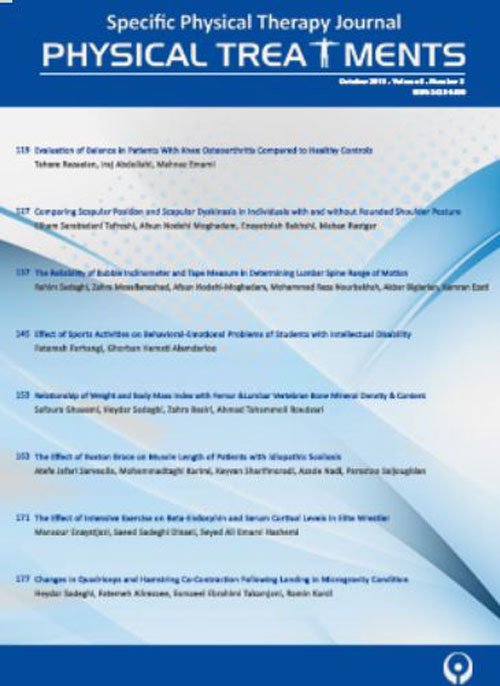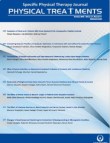فهرست مطالب

Physical Treatments Journal
Volume:8 Issue: 2, Summer 2018
- تاریخ انتشار: 1397/06/03
- تعداد عناوین: 7
-
-
Pages 63-76PurposeGait and balance are functionally related to motor performance. This study aimed to determine biomechanical features of gait in people with intellectual disabilities by reviewing articles published from 1992 to 2017.MethodsIn this systematic review, all quantitative studies related to gait and balance of people with intellectual disabilities were searched from Persian databases (Magiran, Irandoc, IranMedex, MedLib, SID, and Google Scholar) and all full text articles with keywords of “intellectual disability”, “balance”, “postural control”, and “gait” were extracted from English databases (Science Direct, PubMed, EMBASE, Cochrane Review, TRIP, Pedro, CINAHL, ProQuest). Then, after complete review of articles, the English and Persian published papers on biomechanical parameters of gait cycle and balance in intellectual disabilities and related factors were extracted. Also, a “Data Extraction Form” which was developed based on research objectives, was used for data collection. Out of 56 related papers and research projects, 20 articles were excluded due to lack of meeting the inclusion criteria. Finally, 36 papers and research projects were included in this study.ResultsOf the 36 remained studies, the results showed that intellectual disabilities are usually accompanied with gait disorders, especially in step length, stride length, shorter step width, and lower velocity. It also has kinetic and kinematic disorders, including reduction of the ankle production power in the push-off phase, increased hip and knee flexion at stance phase, knee limitation and plantar ankle flexion at the heel contact, and joint stiffness during the gait cycle. The results showed that individuals with intellectual disabilities had significantly lower scores in the balance tests compared to their healthy peers.ConclusionBased on the results, the prevalence of gait disorders and balance in people with intellectual disability is high. Preventive measures should be taken in order to control gait disorders and balance. Therefore, it is suggested that occupational therapists, physiotherapists, sports experts, nurses, and other stakeholders try to find therapeutic strategies for preventing, control, and treatment of gait disorders. Also, because of the lack of intervention studies, future research must move from description to intervention studies in order to provide a guideline in clinical settings.Keywords: Intellectual disability, Postural balance, Gait
-
Pages 77-84PurposeOsteoarthritis is a frequent complication in the middle-aged or older people. Besides pain and swelling, this disease causes deformity and difficulty in walking. The current study compared the effects of 12 weeks bariatric and aerobic exercises on the metabolic syndrome in women with knee osteoarthritis.MethodsIn this quasi-experimental study, 24 women with knee osteoarthritis were selected by convenience sampling method. They were randomly divided into two groups of the bariatric (n=12) and aerobic (n=12) exercises. The training included aerobic and bariatric exercises at 60%-65% rate of the heart rate reserve. The program included a 12-week training, performed three times per week and each session lasted for 30 to 60 minutes. Intra- and inter-group comparisons were performed by dependent t-test and Analysis of Covariance (ANCOVA), respectively. The level of significance was set at P<0.05.ResultsIn both the aerobic and bariatric groups, 12 weeks of exercise program resulted in a significant reduction in weight, body mass index, serum glucose, insulin level, and insulin resistance index. Only in the aerobic exercise group, the concentrations of high-density lipoprotein, low-density lipoprotein, and total cholesterol significantly increased and decreased, respectively. The levels of triglyceride significantly decreased in both groups. Only in the aerobic exercise group, the maximum amount of oxygen consumption was significantly increased.ConclusionIn women with knee osteoarthritis, 12 weeks of aerobic and bariatric exercises positively affect the levels of insulin resistance markers, lipid profiles, and max-oxygen consumption. Therefore, these two exercise programs can be used to maintain health of these people.Keywords: Exercise, Knee osteoarthritis, Insulin resistance, Lipid
-
Pages 85-92PurposeThis study aimed to investigate the effect of an 8-week program of selected Pilates exercises on the performance test scores of male adolescent students with mild (teachable) Intellectual Disability (ID).MethodsThis was a quasi-experimental study with a pretest-posttest and control group design. Study participants consisted of 30 individuals with ID. The study subjects were 10- to 15-year-old male students who were randomly selected by the convenience sampling method from the students of special schools in Parsabad City, Iran. The subjects were randomly assigned to the control (15 subjects) and experimental (15 subjects) groups. A set of tests were used as the performance test. The experimental group’s exercise program included Pilates exercises. The subjects performed the exercises for 8 weeks (3 sessions per week). The Independent t test and Paired t test were used to analyze the data.ResultsIn the experimental group, the results of this study revealed a significant difference in star excursion to extension (P=0.001), star excursion to abduction (P=0.004), vertical jump (P=0.001), 3 times single-leg jump (P=0.001), shuttle run (P=0.001), and stair sprints (P=0.003) after performing the exercises (P=0.05). However, there were no significant differences in star excursion to flexion (P=0.13) and single-leg jump (P=0.18) in the experimental group and the results of all tests in the control group (P≥0.05).ConclusionPilates exercises seem to improve the balance and function of lower limbs in individuals of the ID group.Keywords: Exercise, Intellectual Disability, Function, Balance
-
Pages 93-98PurposeThe present research evaluated the effect of using a back brace for 8 weeks on the Electromyography (EMG) activity of the selected muscles among individuals with chronic back pain in the mid-stance phase of walking.MethodsThis quasi-experimental research evaluated 22 women with chronic back pain in terms of erector spinae muscles activity, abdominal erectus, abdominal external oblique, and abdominal internal oblique. The study participants were randomly selected and divided into the experimental and control groups. The experimental group employed back brace for 8 weeks. Before and after using the brace, the EMG activity was recorded in both groups. The Independent t-test and Paired t-test were used to analyze the data (P≤0.05) in SPSS.ResultsIn the experimental group, the EMG activity of erector spinae and abdominal erectus muscle in the mid-stance phase of walking was significantly less than that of the control group. However, there was no significant difference in respect of external and internal oblique muscles in the experimental group compared to the controls (P>0.05).ConclusionUsing brace can reduce the activity of erector spinae and abdominal erectus muscle in the mid-stance phase of walking. Kinematic and kinetic studies are necessary to describe the reasons for these changes because of back brace use.Keywords: Back pain, Brace, Walking
-
Pages 99-106PurposeMany research studies reported balance disorder as one of the most important consequences of Functional Ankle Instability. However, the Balance Recovery Strategy, which its deficiency can cause poor balance or secondary damages, has not been investigated in previous studies yet. The purpose of this article is to study the Balance Recovery Strategy in athletes with Functional Ankle Instability during jumping and landing.MethodsFifteen male athletes with Functional Ankle Instability and 15 healthy male athletes were randomly assigned into two experimental and control groups, respectively. The subject’s Balance Recovery Strategy was observed by Surface Electromyography and during single-foot jumping and landing. In order to evaluate the Balance Recovery Strategy, the ratio of the total activity of the selected hip joint muscles to the total activity of the selected ankle muscles was evaluated. The Multivariate Analysis of Variance (MANOVA) was used to compare the Balance Recovery Strategy between the two groups. Significant level was considered as ≤0.05 in all the statistical analysis.ResultsThe results of the statistical tests showed a significant difference between the two groups with regard to the Electromyography activity of femur muscles and ankle muscles. That is, the subjects with Functional Ankle Instability are more likely to use the hip strategy than the ankle strategy to regain their balance. While the group of the healthy subjects used the ankle strategy.ConclusionThe transfer of the Balance Recovery Strategy from the ankle to the hip joint in the subjects of the Functional Ankle Instability group can be attributed to their proprioception deficit and a decrease in the ankle muscle strength. The reason is that proprioception deficiency can change the motor control programs in the Functional Ankle Instability group.Keywords: Balance RecoveryStrategy, FunctionalAnkle Instability, Athlete, Jump-landing
-
Pages 107-114PurposeRecently, the Functional Movement Screen (FMS) and Y Balance Tests are used to assess the key movement patterns, dynamic stability and to identify individuals at high risk of injury. But, there are few studies to assess the relationship between the FMS test and Y Balance Test. This study aimed to assess the relationship between dynamic stability and the FMS test.MethodsThe subjects of this study were 95 students (Mean±SD age=26.7±3.13 y, Mean±SD height=177.4±6.9 cm, Mean±SD weight=72.02±6.91 kg, and Mean±SD BMI=22.93±0.41 kg/m2) from a university complex. All subjects were evaluated prior to the onset of training. Y Balance Test was used to evaluate dynamic stability and FMS test for evaluating the movement patterns of the subjects.ResultsThe Pearson correlation coefficient was used to assess the relationship between variables. The results showed a significant association between the FMS score and the aggregate Y score (r=0.205, P=0.04). Also, there was a weak correlation between FMS and normalized posteromedial reach (r=0.27, P=0.04). However, the correlation between FMS and normalized anterior reach and posterolateral reach was not statistically significant (P>0.05).ConclusionThese findings demonstrate partial correspondence between the two tests. However, the relationship is not strong enough to consider them interchangeable. Thus, dynamic postural control is not a large component of the aggregate FMS score.Keywords: Movement screening, Dynamic balance, Y Balance Test, Functional Movement Screen (FMS)
-
Pages 115-121PurposeIschemia-Reperfusion (IR) injury is one of the most common cardiac disorders leading to irreversible heart damage. Many underlying mechanisms seem to be involved, among which disruption of cellular autophagy balance. Since physical training has a beneficial effect on the improvement of autophagy balance, it may have a cardioprotective effect against IR injury. This study investigates the protective role of aerobic training from cardiac IR injury and the autophagy process as a possible mechanism.MethodsThirty-two male Wistar rats (8 weeks old) were divided into control, sham, control plus IR, and training plus IR groups (8 rats each). The training group was exercised aerobically on a treadmill for 8 weeks (5 d/wk). After 8 weeks, the anesthetized rats underwent left thoracotomy (sham, control plus IR, and training plus IR groups) to access the left anterior descending coronary artery, which was occluded by a silk suture for 30 min and then released for 90 min of reperfusion (IR groups). Triphenyltetrazolium chloride staining was used to determine the infarct size. The gene expression of Beclin-1 was evaluated by real-time polymerase chain reaction. One-way ANOVA was used for statistical analysis with the significance level set at P≤0.05.ResultsThe cardiac infarct size was smaller in training plus IR (20.24±5.7%) group compared to that in the control plus IR (35.9±2.3%) group (P≤0.05). On the other hand, IR operation significantly increased the gene expression of Beclin-1, while exercise training prevented expression of the mentioned gene in training plus IR group (P≤0.05).ConclusionAerobic training can protect the heart against Ischemia-Reperfusion injury. It seems that improvement of autophagy balance during IR injury may be involved in exercise-induced cardioprotection against Ischemia-Reperfusion.Keywords: Aerobic training, Cellular autophagy, Ischemia-Reperfusioninjury, Cardioprotection


